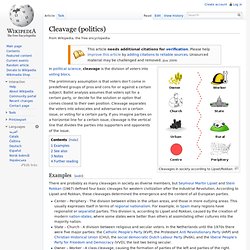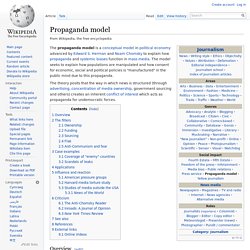

Virtuelles Magazin für Popkultur. Netzwerk Abriss Berlin. An Alfred Hitchcock documentary on the Nazi Holocaust. Cleavage (politics) Cleavages in society according to Lipset/Rokkan In political science, cleavage is the division of voters into voting blocs.

The preliminary assumption is that voters don’t come in predefined groups of pros and cons for or against a certain subject. Ballot analysis assumes that voters opt for a certain party, or decide for the solution or option that comes closest to their own position. Cleavage separates the voters into advocates and adversaries on a certain issue, or voting for a certain party. If you imagine parties on a horizontal line for a certain issue, cleavage is the vertical line that divides the parties into supporters and opponents of the issue. There are probably as many cleavages in society as diverse members, but Seymour Martin Lipset and Stein Rokkan (1967) defined four basic clevages for western civilization after the Industrial Revolution.
Contemporary ballot analysis speaks of the emergence of new cleavages. Seymour Martin Lipset. Seymour Martin Lipset (March 18, 1922 – December 31, 2006) was an American political sociologist, a senior fellow at the Hoover Institution at Stanford, and the Hazel Professor of Public Policy at George Mason University.

His major work was in the fields of political sociology, trade union organization, social stratification, public opinion, and the sociology of intellectual life. He also wrote extensively about the conditions for democracy in comparative perspective. Early life and education[edit] Academic career[edit] Lipset was the Caroline S.G. Lipset was a member of the National Academy of Sciences. Awards[edit] Lipset received the MacIver Prize for Political Man (1960) and the Gunnar Myrdal Prize for The Politics of Unreason. Public affairs[edit] Lipset was active in public affairs on a national level.
Realigning election. Realigning elections typically separate Party Systems—with 1828, for example, separating the First Party System and the Second Party System in the U.S.

Political realignments can be sudden (1–4 years) or can take place more gradually (5–20 years). Most often, however, particularly in V. O. Propaganda model. The propaganda model is a conceptual model in political economy advanced by Edward S.

Herman and Noam Chomsky to explain how propaganda and systemic biases function in mass media. The model seeks to explain how populations are manipulated and how consent for economic, social and political policies is "manufactured" in the public mind due to this propaganda. The theory posits that the way in which news is structured (through advertising, concentration of media ownership, government sourcing and others) creates an inherent conflict of interest which acts as propaganda for undemocratic forces. Overview[edit] Investment theory of party competition. Overview[edit] However, this is different from a corporatist system, in which elite interests come together and bargain to create policy.

In the investment theory, political parties act as the political arms of these business groups and therefore don't typically try to reconcile for policy. Labor-intensive investors[edit] A study by Larry Bartels found a positive correlation between Senate votes and opinions of high income groups similar to the conclusions in the investment theory.[4] Labor-intensive investors made up much of the early political systems in the 18th and 19th centuries. These industries are also heavily against labor unions, since unionization increases the price of their goods. Capital-intensive investors[edit] Due to industrialization and new markets in the 20th century, capital-intensive investors became the new economic order after the realignment of the Great Depression.
Comparison to other election theories[edit] See also[edit] References[edit] External links[edit] Open Source P2P Geld. Blätter für deutsche und internationale Politik.